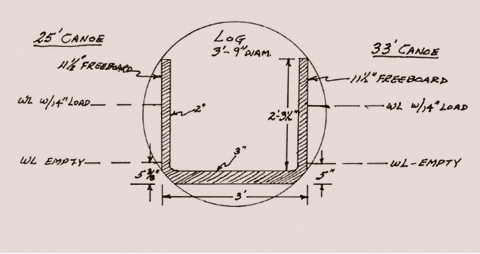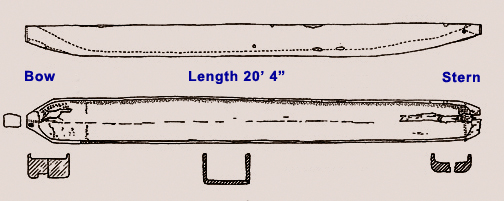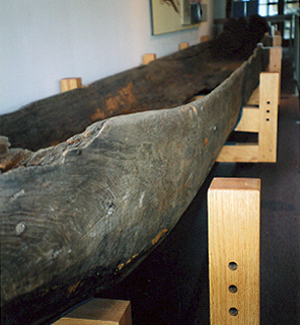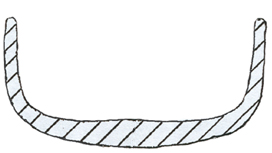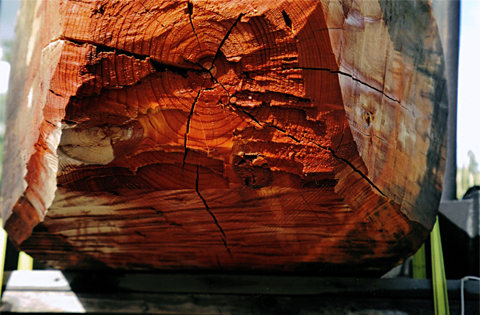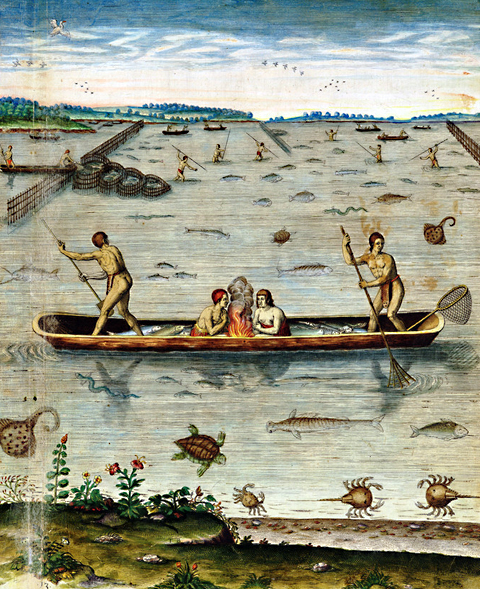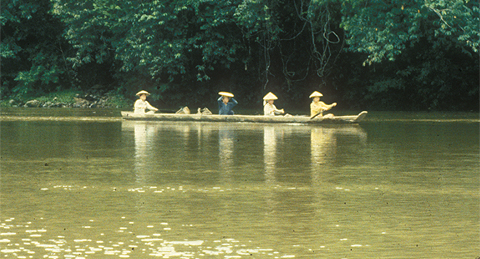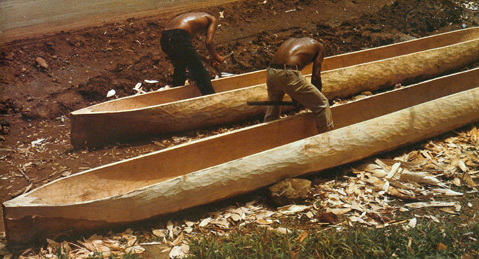This canoe has a flat “bottom,” small, 45° “chines”–the transitions, usually rounded, from the bottom to the sides–and vertical “sides” with no “flare” outwards.
Figure 4
Yakutat Indian Dugout Canoe
Courtesy Bill Durham, Canoes & Cayaks of Western America, p. 46.
The bow is to the right; the indentation is an ice cutter.
Figure 6
“Spalding/Peo peo tah likt Canoe”
Cross-section at 23′ from bow
Sketch courtesy of Bob Chenoweth, Nez Perce National Historic Park, Nez Perce National Historical Park (NEPE) Collection, Spalding, Idaho; NEPE 5048.
Overall length: 30′ 2 3/8″
Outside width, max: 34″
Height: 16½”
Weighing In
In addition to his perhaps naïve conception of a canoe hull, there is a disconnect in Boss’s weight figures. Interestingly, he assumed a fairly thin 33′ canoe: 2″ thick at the sides, and 3″ at the bottom (close to Chittenden’s description of nineteenth century Missouri River dugouts), yet using a given weight of poplar per cubic foot, he arrives at a weight of 2,565 pounds. He also allows solid ends 18″ long. I am not questioning his math, but Phil Johnston’s actual 33′ dugout in Ponderosa pine (similar weight to cottonwood), with 3″ sides and a 6″–7″ thick floor (about twice as much wood as Boss’s proposed boat), actually weighs less: 2,400 pounds. I believe Boss’s estimate, for cottonwood dugouts that thin, is at least 1500 pounds heavy, as proved by the actual re-enactor boats. Bob Evans, of the Great Falls Lewis and Clark visitor center, also believes the two large Lewis and Clark dugouts weighed closer to 1,000 pounds.
Boss also noted some of the more interesting passages in the journals on coastal Indian canoes, including Clark’s “they are dug thin,” implying the expedition boats were thicker; the Indian boats were indeed light, as Lewis observed: “so light that four men can carry her on their shoulders a mile or more without resting.” If we assign 100-200 pounds per man for a mile without resting, the weight of the Indian dugout (probably Nootkan, Boss says, 20-28 feet), was 400-800 pounds. Of course, those Indian boats were lower river, estuary and ocean boats, and did not need to be as thick as boats made to descend the rocky Clearwater.
However, even the upriver fishing dugouts on the Clearwater were not nearly as heavy as Boss imagined. The four Nez Perce historic canoes at Lapwai have sides about an inch thick at the gunwales, and widely varying thickness at the bottom: perhaps two to seven inches. I asked Bob Chenoweth what those and other historic (nineteenth century) Northwest dugouts weighed. He said he had never heard of one being weighed. I could lift one end of the Spalding canoe, however, easily, just with my arms, without using legs or back (meaning no more than 80 pounds lifted with the opposite end grounded). We both guessed that the 30′ dugout weighed no more than 200 pounds. Granted, parts of it are thin or missing, and the wood has been drying for over a hundred years, but that canoe is not in the two-thousand pound class. Or the one-thousand pound class. It’s a fair guess that a 33′ dugout (versus 30′) of that design, unbroken and a bit green, might weigh 400 pounds at most. Versus the Orofino replica at 2,400 pounds.
So, although Boss left us with excellent and meticulous descriptions and diagrams of the barge and pirogues, his guesses on the canoes, which were never described by Lewis and Clark, helped begin a tradition of very heavy dugouts.
As re-enactors ramped up their boat building for the bicentennial, Boss’s 1993 article was almost the only guide; he suggested a very square design, a very heavy boat, and his models also showed a rough exterior. Thus the tradition of rough, heavy, crude canoes was carved into most Lewis and Clark replicas.
Most of the “replica” Lewis and Clark dugout canoes used by re-enactors and sitting in parks or museums are roughly carved, crudely shaped, and weigh from 800 to 3,000 pounds. Actual nineteenth century dugouts, however, both those few surviving and those known by nineteenth century description, can be smoothly finished, finely shaped, and weigh from under 200 to 800 pounds. When historian Hiram Chittenden (1858–1917), in 1903, characterized nineteenth century cottonwood dugouts on the Missouri, he described a “round log shorn of all roughness and irregularity. . . . a regular canoe model. . . . a shell about two inches thick at the bottom and one at the rim,” concluding: “These log canoes made excellent craft, strong, light, and easily managed.”
This essay is an attempt to add a canoeist’s eye to the scholarship. The “sources” in this case, in addition to the previous scholarship, the replicas, the expedition’s journals, and canoe history, include river tests of replicas, and my own canoeing experience. We will examine a number of difficult canoeing situations, especially as the expedition ascended the Missouri Breaks and descended the Snake River. I hope this will shed new light on what kinds of canoes they might have made, and what they did with them on the rivers.
Issues
Among the more than one million words in the extant journals of the transcontinental voyage of Lewis and Clark and the Corps of Discovery, added to the practically incalculable number in all the published Lewis and Clark scholarship (as of May, 2013), there are almost none that provide us with any specific information about their most reliable conveyances, the dugout canoes that carried them much of their way from Fort Mandan to the Pacific Coast and all the way back from the east side of the Bitterroot Mountains to Saint Louis.
Yes, we know that some were carved from cottonwood logs and some from ponderosa pine. And yes, we’re told that at Fort Mandan, two canoes were 24′ and 33′ long respectively, and both 3′ wide, and on the return, that two were 28′ long, 16″ and 24″ wide, and 16″ deep. Those two small boats were later lashed together as a catamaran on the Yellowstone. But that’s all we’re told about physical dimensions. There’s nothing helpful on the hull design or thickness, or the total weight. There’s not even a single passing remark such as “Four men could lift the large canoe over their shoulders but two men could not,” which would suggest a canoe weighing perhaps 400 to 800 pounds.
This investigation of the Lewis and Clark dugout canoes and canoeing began in 2004, the bicentennial of the years (1804–06), in which Lewis and Clark set out from Wood River and St. Louis to ascend the Missouri River, then descend the Columbia drainage to the Pacific, and return. The Lewis and Clark Trail Heritage Foundation was incorporated in 1969, and in 1974 their quarterly publication, We Proceeded On, began as a newsletter and soon evolved into an illustrated journal. However, in the 487 articles published in WPO up to May 2013, only a few have dealt with the Corps of Discovery’s transportation–concerning the first replicas of the barge (called the ‘boat’ or ‘barge’ but never the ‘keelboat’), 2 articles; Lewis’s “iron boat,” 6 articles; and the pirogues, 2 articles.
In addition to the scholarship building towards the bicentennial in 2004, various re-enactor groups from Missouri, Montana and Idaho, were coming to the Missouri River with their replica dugouts. Many of them had combed the journals for evidence of canoe design before they began the tedious and expensive process of carving giant logs. The re-enactors confirmed my suspicion that the journals contained almost no references to the design and weight of the dugouts. Moreover, I gradually realized that few of the scholars or re-enactors were advanced river canoeists, aware of canoeing issues.
Since there is no journal passage which even hints at what the Lewis and Clark dugouts looked like, nor any contemporary document (circa 1800) that I have found describing the Lewis and Clark canoes, this essay is necessarily a personal exploration by one canoeist who has researched the subject, but lacking definitive answers, must make a variety of educated guesses. That said, the dugouts have received little attention, and I am certain that some leading popular as well as scholarly impressions of the dugouts are not supported by canoe or canoeing history.
I began with admiration for the work of Richard Boss and Arlen Large on the Lewis and Clark boats, and I was impressed with the knowledge of the journals among the many re-enactors I met. When I first saw the replica dugouts, however, as a canoeist I was a bit surprised and skeptical. The replica hull designs looked more like a “scow” fishing boat than an expedition river canoe. I wouldn’t want to build a two thousand pound boat with a flat bottom and vertical sides, load it with three thousand more pounds, and haul it a thousand miles up the Missouri river in high water.
Scholars
Four scholars have written about the boats of the expedition: Richard Boss[1]Richard C. Boss, “Keelboat, Pirogue, and Canoe: Vessels Used by the Lewis and Clark Corps of Discovery,” Nautical Research Journal, 29:2 (June 1983), 68-87., Arlen J. Large[2]Arlen J. Large, “The Rocky Boat Ride of Lewis and Clark,” We Proceeded On, 21:1 (February 1995), 16-23., Verne Huser[3]Verne Huser, On the River with Lewis and Clark (College Station: Texas A&M University Press, 2004)., and Bob Chenoweth[4]Robert Chenoweth, “Wali-mliyas: The Nez Perce National Historical Park Dugout Canoe Collection and Dugout Canoe Use Among the Nez Perce Indians,” Northwest Journal of Anthropology, 42:2 … Continue reading. Of these, only Chenoweth has examined any of the few existing historic canoes with a canoeist’s eye. His concerns are similar to mine.
Richard Boss
Boss is an excellent naval historian and mathematician, but naval (ocean-going) vessels do not have to be carried around rapids, and Boss was more interested in the huge “keeled boat” (which the journalists called either “the barge” or “the boat”) and the two pirogues (long rowing boats with planked sides) than in the lowly dugouts. The barge and pirogues are described in the journals, and some are illustrated in Clark’s drawings. In his article for the Nautical Research Journal in 1993, Boss developed detailed designs of the barge and pirogues, and reproductions based on those designs have been well executed by groups from Onawa, Iowa, and from Pittsburgh. I paddled with the St. Charles, Missouri, re-enactors, and the Onawa barge and pirogues, and the St. Charles dugouts, at the mouth of the Marias during the bicentennial.
Finding little evidence in the journals or the scholarship suggesting canoe design, Boss in 1993 drew this proposed cross-section of a Lewis and Clark dugout hull (see Fig. 1).
Perhaps Boss’s design was based on Nez Perce canoes in the Nez Perce National Historical Park collection on the Clearwater or on canoes at Fort Clatsop, before 1993, when Boss’s article appeared. He was working with the Fort Clatsop National Memorial and the Park Service to develop models of the boats of the expedition. We do not know what Boss actually saw, but from 1990 to 1993, when his article appeared, there were dugout replicas at Fort Clatsop, and historic Nez Perce canoes four hours away by car, near Lewiston, Idaho. Sally Freeman, at the Fort Clatsop National Memorial, kindly found pictures of two replica canoes probably carved by park rangers, that were exhibited at Fort Clatsop and nearby Cape Disappointment Lewis and Clark State Park in the early nineties. They are both moderate in design, carved neither light nor very heavy, neither very rough nor very smooth, with some chines but fairly square. They definitely resemble Nez Perce fishing canoes more than the sleek coastal dugouts.
In the lobby of the museum at the Nez Perce National Historical Park (NEPE) near Lapwai, Idaho, according to curator Bob Chenoweth, Richard Boss could have seen at least two rare original Nez Perce canoes, NEPE 5047 and 8734 (figs. 2 and 3). Both are Nez Perce fishing canoes. Note the squared middle, and the substantially thicker bottoms at each end, particularly at the bow, useful for landing bow first on rocky shores. The thick, squared-off bows with rake (a gently sloping bow line, versus a vertical bow), make an excellent platform driven up on shore, so disembarking passengers with armloads of fat salmon can simply walk off the bow onto land. Any canoeist will appreciate that feature, versus a sideways landing in moving, shallow water, five feet out from shore. The wider and heavier bow also serves to counterbalance a solo paddler, and to carry loads. These canoes were often used as ferries across the river, and are well suited to the demands of the Clearwater Nez Perce. Boss, the first scholar to draw a Lewis and Clark canoe hull, had probably seen canoes of this type.
Chenoweth notes that Clark described almost exactly such a canoe as 5047, above, in his journal entry of 25 September 1805, on the Clearwater, when Nez Perce canoes approached:[5]Chenoweth, interview by Joe Mussulman, October, 2013.
one of the young men took his guig and killed 6 fine Salmon two of them were roasted and we eate, two Canoes Came up loaded with the furniture & provisions of 2 families, those Canoes are long Stedy and without much rake.
If you look again at the two Nez Perce canoes above, 8734 has considerable rake; while 5047 has very little. In this rare observation, Clark reveals that he is quite conscious of varying canoe designs. Bill Durham noted that inland Columbia plateau people made both “sharp” dugouts, much like our conventional canoes, and blunt, platform-ended “punt” or scow canoes, like the two above.[6]Bill Durham, Canoes and Kayaks of Northern America. (Seattle, WA: Copper Canoe Press, 1960). The platform ends are useful for standing—fishing, gigging, poling or throwing nets—as well as disembarking. Near the coast, where waves are a big issue, the Haida design sometimes featured a vertical cutwater (the bow at waterline was a vertical knife edge with no rake at all), while above the cutwater, the high, raked, and flared sides threw off the waves and spray (See Fig. 4)
At Lapwai, the more rounded and sophisticated canoe—the no. 5048, or “Spalding”—may have been in storage at the time of Boss’s visits. The differences between the Spalding canoe, which Boss probably did not see, and the above fishing canoes, are actually quite important, since the Boss diagram may be a false lead, and since it has been so influential. The Spalding canoe, has been in storage in 1990–93 (See Fig. 5 and 6).
Bob Chenoweth at Lapwai is one of the foremost experts on Northwest Indian canoes, and an accomplished white water canoeist and kayaker. He says that the 1836 Spalding canoe has finding pegs [define “finding pegs.”] which the Nez Perce were never known to use, but coastal tribes did, and its rounded shape, with soft chines and a flared-out side, is a downriver hull shape. The finer entry hull cuts through water more efficiently, and the flared sides throw off chop from wind and waves, all suited to lower Columbia conditions (as well as lower Missouri conditions), making this a better canoe for longer trips, open windy water, and strong currents. Bob thinks the canoe was probably made downstream for Rev. Spalding, and brought upriver.
On the other hand, the flat-bottomed scow boats such as NEPE 8734, as we have noted, are good in shallow water, and the shovel noses are useful for fishing and landing. The Clearwater River in the Nez Perce region near Lewis and Clark’s canoe camp, is both a strong river with riffles and rapids in high water, and being a snow melt river near the Divide, is also quite shallow in low water, with rocks, and sand and gravel bars. The Expedition, beginning at the Nez Perce settlement near present day Orofino, had quite a bit of trouble descending the rocky rapids of the Clearwater in the low water of October
Boss does not say why he chose his squared-hull design, but he was not a river canoeist, and was apparently not aware of the distinction between blunt, flat-bottomed fishing boats, and sleeker travelling canoes. Boss’s proposed design, illustrated above (Fig. 1), resembles a square sided Nez Perce canoe, not necessarily what Lewis and Clark would have carved, even with Nez Perce help on the Clearwater, especially since they had already carved dugouts at Fort Mandan, probably based on their knowledge of eastern, Indian, and voyageur canoes. However, Boss’s squared and blunt design, the only published investigation of the Lewis and Clark dugouts, was highly influential among re-enactors and replica makers.
Arlen J. Large
In his six-page article, Large offers a narrative overview of the party’s time on the water, pursuing Jefferson’s dream of a water passage to the west. He covers all the craft involved, and illustrates a few of their problems by reviewing some of the more dramatic boating incidents. This was a fine introduction to the boats, and boating, but Large was not investigating issues of canoe weight, design, or performance.
Verne Huser
An experienced riverman, Huser includes canoeing and professional raft guiding on the Snake River, and he is also a colleague of mine in western literature and history. Very few of the re-enactors or scholars were advanced canoeists, and the Lewis and Clark expedition negotiated some substantial class III-IV water, so Huser has some excellent observations on the canoeing problems the expedition faced. But his timely book was concerned with incidents of canoeing, not with incidental journal evidence of canoe design. He accepted the convention of relatively “primitive,” heavy canoes. The canoes were, of course, heavily loaded, but that does not mean the boats themselves were clumsy.
Bob Chenoweth
In 2008, Chenoweth published an important article on the Lewis and Clark canoes, after the bicentennial and our river test. He is the curator at the Nez Perce National Historical Park at Lapwai, Idaho, and has access to the historic native canoes in the Columbia drainage. He has carefully traced the provenance and compared the design of 5 existing historic Nez Perce canoes from as early as 1820. He is also a canoeist and kayaker, and describes very well the variations in canoe design from the Clearwater to the Snake and to the lower Columbia, with their differing water conditions, and also the variations at any one place to serve different uses—solo paddling, fishing, standing and spearing, traveling, etc. Although, as we have seen in figures 1 through 5, several of his canoe specimens are close to Boss’s diagram, with little flair and little chine (that is, almost 90° from bottom to sides), Chenoweth has the same canoeist’s misgivings that I do about straight sides with no chine. In his discussion of the 1836 “Spalding canoe” (NEPE 5048, Fig. 5), Chenoweth wrote:
NEPE 5048 . . . exhibits several distinguishing features not observed in other [of the five Northwest] canoes or in the record of historic photographs. The first is the somewhat pronounced cutwater at the bow and a distinct chine. Next is the rounded and raised stern. Lastly, this canoe has flared sides unlike the other extant examples. These features all provide an advantage in open water and during long distance travel. There is also less possibility with this type of cross-section of the canoe being pulled under in a current perpendicular to the sides (a cross or side current) . . . The flared sides would provide better protection from choppy water generated by either a head-wind or cross-wind.[7]Chenoweth, 191.
When we consider that Lewis and Clark made their first canoes at Fort Mandan, and in the first thousand miles of the Missouri had seen plenty of wind and choppy water, and had as their models the eastern and Alexander Mackenzie birch canoes and dugouts with round bottoms and flair and sometimes rocker (as well as the ubiquitous scows), we have no reason to believe they would have made a Nez Perce fishing boat, nor would they have made it crudely. In short, they were familiar with canoes; Boss was not.
River Test, 2005
The turning point for me was the river testing of three replica dugouts.[8]See on this site, Testing Dugout Canoes. I respected the re-enactors and wanted to test their products. As far as I could ascertain, no one had ever paddled their dugouts or similar boats in difficult water. Thanks to Phil Johnston of Orofino, Idaho, and Walt Marten of Columbus, Montana, we had the loan of three dugouts: Marten’s, the smallest (18′ 6″), weighed 800 pounds; the largest (33′) by Johnston, 2,400 pounds. I assembled a crew of ten expert paddlers from Missoula, including several national champions in canoeing and kayaking, and we–apparently for the first time–paddled replica dugouts in real water: the “Big Eddy” of the Clearwater River, below Orofino, where Lewis and Clark had problems in their first days out of “Canoe Camp” in 1805. The Clearwater was high, running 13,500 cfs (cubic feet per second) when we put in, with ripping eddy lines and three-foot standing waves in the channel.
We found–as River Test videos show–that those heavy dugouts were stable. Too stable. We spent six hours trying to get into trouble, and no one capsized. We paddled the canoes swamped—approximating the heaviest possible load—we paddled full speed across eddy lines at 90 degrees, we paddled straight into waves, we even surfed. Lewis and Clark, of course, would have avoided all such difficulties whenever possible; they had, shall we say, little interest in recreational canoeing, and therefore no need for such stable canoes. As we will see, stability in a canoe is a concern for amateurs, which they were not. I wondered why they would want to haul logs that heavy a thousand miles upstream to carry their gear. I began to suspect that a tradition with unexamined conventions–the canoes were thick, heavy, clumsy–had slowly grown to be taken as truth.
In the light of the river test, certain things became clear. The re-enactors have contributed a great deal to Lewis and Clark knowledge. They have raised awareness and taught history up and down the rivers. And their barge and pirogues are magnificent replicas–but those boats were drawn and described by Clark.
However, in relation to the dugouts, the re-enactor groups have the opposite needs of Lewis and Clark. They spend a lot of time and energy making a boat, and a thirty-three-foot log, three feet in diameter, is expensive. They want it to last. A thick, heavy dugout is easier to carve, holds up better without cracking in years of sitting out in the sun on a trailer or in front of a museum, and can carry six non-canoeists without turning over. The longer it lasts, which means the thicker, the better. They do not lift the boat out of the water themselves (much less carry it on portage); it goes directly onto a boat trailer, which is backed into the river at access ramps. The boat floats off the trailer, and floats back on. Weight doesn’t matter. And heavier boats, especially bottom heavy as we proved, are more stable. Our 33′ pine boat had a bottom 7″ thick. In technical terms, the test boats were not canoes, with buoyant hulls poised on the water, so much as battleships, with ballast hulls sunk in the water. One of our paddlers took the twenty-four-foot dugout, weighing 1,400 pounds empty, three feet offshore, stood up in it, then stood balanced with both feet on one gunnel, holding his paddle, and laughing. The canoe did not turn over. Too stable. Those heavy boats suit the re-enactors’ need for stability, and last for decades.
Lewis and Clark, on the other hand, had very different needs. They wanted the lightest boats practical to carry the most gear possible upriver, by paddling, by lining (pulling with a rope), by poling, and by sailing. The first thing Lewis did when the new dugouts were finished at Fort Mandan was to “put one of the canoes into the water to ascertain what weight they would carry,” that is, how high it floated, what its weight to displacement ratio was. “We found they would not carry as much as was expected, and Captain Lewis agreed to take a large periogue along.”[9]Patrick Gass in Moulton, Gary E. The Journals of Lewis and Clark Expedition. (Lincoln, NE: University of Nebraska Press, 1983–2001), 10:75. Also, in contrast to the re-enactors’ canoes, the expedition dugouts were almost throwaways: yes, they buried them at the headwaters, expecting to use them on the return trip (and did), but the canoes really had to last only one season for sure.
Romantic Primitivism
In addition to these practical reasons for the thick and heavy replica boats, there is a cultural issue: many of the replica dugouts tend to be carved roughly, with facets showing, almost as if shaped by axe work alone. This would increase hull friction in the water, and hence increase the force needed to pull the boat upstream. Painters’ visions helped shape this tradition; see John Clymer’s painting “Captain Clark—Buffalo Gangue” (1976) of a buffalo herd crossing the river near Clark’s dugout. That painting was recent and well known to re-enactors carving boats before the 2004 Bicentennial. The bow of the dugout in Clymer’s painting is extremely rough and squared off, an evocation of the crudeness of “The West.” So is the bow of one Orofino re-enactor’s dugout (See Fig. 7 and 8).
Why so crude? The re-enactors and replica builders have been misled not only by the scholars, but also by a cult of “primitivism.” It may seem odd in a discussion of Lewis and Clark canoes, but there’s an aesthetic tradition behind the crude canoe replicas. The American West opened by Lewis and Clark and others is supposed to be rough and ready, unfinished, crude—but also wild and natural, and therefore, beautiful. Lewis himself touches on these themes in his famous soliloquy on the wild beauty of the Missouri breaks (well treated by John Logan Allen[10]John Logan Allen, Passage through the Garden: Lewis and Clark and the Image of the American Northwest. (Urbana: University of Illinois Press. 1975).), squarely in the Romantic tradition of “the sublime” found in wild nature.
However, wild nature was not always seen as beautiful. Between 1600, the era of Shakespeare and the King James Bible, and 1800, the era of Jefferson, Lewis, and the opening of the trans-Mississippi west, the Christian map of the universe had changed 180 degrees. In 1600, God, at the center of a concentric universe, was associated with order and surrounded by man and his works (civilization), and at the far periphery of that universe was chaos, the home of Satan, and wildness. When Jesus was lost, he wandered “in the wilderness,” meaning the desert, according to the King James Bible translation (1611). And when William Bradford stepped off the Mayflower, in 1620, into what we would now call a beautiful and untouched New England deciduous forest, he wrote in his journal: “I have come to a hideous and desolate wilderness.”
What a perfect time to “discover” the American West! John Wesley Powell correctly saw the country beyond the hundredth meridian as mainly arid. But the emptiness itself, the lack of civilization, had become a virtue, hence Lewis’s rapture in the barren hills of the Missouri Breaks, well treated by John Logan Allen, squarely in the Romantic tradition of the sublime. It is no accident that this cultural valuation of nature without man helped the white men overlook the native civilizations, in order to apprehend the west as wild. Out west, there would be debilitating refinements, no arts, just wild and simple nature.[11]For details of this complex and important cultural shift, see Roderick Nash, Wilderness and the American Mind. For a fifteen page summary of these themes in relation to western American culture, see … Continue reading
Ten years before Lewis headed west, Jefferson’s friend Chateaubriand was writing back to France that “nothing is old in America but the trees . . . and liberty . . . these are worth as much as monuments and ancestors.”[12]Chateaubrian as quoted by Hans Huth, Nature and the American (Berkeley, University of California Press, 1957, 50. Original French translated by author. Wow. The Louvre replaced by a forest? In 1792 in upstate New York, Chateaubriand said that he was seized with “a sort of delirium in the absence of roads, towns, laws and kings: In this deserted region the soul delights to bury and lose itself amidst boundless forests . . . to mix and confound . . . with the wild sublimities of nature.”[13]Chateaubriand as quoted by Roderick Nash, Wilderness and the American Mind (New Haven, Yale University Press, 1967), 49. So Bradford’s “hideous and desolate wilderness” had in two hundred years become a sublime (“wild sublimities”) refuge for the soul. William Bartram’s journals were in Jefferson’s library when Lewis lived with him. Camping in Florida in 1775, Bartram wrote: “Our situation was like that of the primitive state of man, peaceable, contented and sociable.”[14]Bartram as quoted in Nash, 55.
Huck Finn was last seen heading west, at the end of his book, in 1884: “But I reckon I got to light out for the Territory ahead of the rest, because Aunt Sally she’s going to adopt me and sivilize me and I can’t stand it. I been there before.” Twain, from Missouri, nailed it. The West is the opposite of, and the answer to, the complexities of civilization.
Surely the canoes were crude.
In the absence of detailed descriptions in the journals to guide them, and with centuries of European bias towards the frontier as “primitive,” and with dugouts regarded as a crude type of canoe, and with western crudeness itself valued, many re-enactors clearly had their own needs and dugout preferences: maximum stability, a long shelf life, and a primitive look that parked outside a school or museum said, “This is old. This is history. This is the West.”
The problem is, canoes have been beautifully crafted in many civilizations around the world for thousands of years. That seems to have been lost in our romance of Lewis and Clark conquering the wilderness long ago with the crudest of tools.
Interesting cultures are usually rich in paradox, and the “primitive” was valued in 1800 partly because it was already doomed by “progress.” That same science, beginning with telescopes and microscopes, that for two hundred years had shifted our respect from the “otherworldly” to the incredible subtlety, complexity and beauty of this world, was soon destroying what it loved. Imagine that you are 55 years old: At your birth, Lewis set out; by the time you were 40, Gilpin and other developers were imagining a west of factories; by now, at 55, the transcontinental railway has been completed. The “wild west” fell not to the captains of the Corps of Discovery, but to the captains of industry. Soon the “modern” would be the face of our culture.
So a rough, heavy, crude canoe in front of a museum is both a hymn to a simple, primitive past that we have lost, and is also obviously, hopelessly inferior to our modern, scientific present.
This cultural bias against the past runs through the canoe scholar-ship. In Shakespeare’s day, educated people assumed that civilization could never rise again to the glory of Greece and the grandeur of Rome, thousands of years previous. In our day, the dogma of “progress” suggests that all previous endeavors were “primitive,” inferior. Both positions are indefensible. Anyone interested in the dugout canoes of 1800 might begin by looking at American and continental inlaid furniture of the eighteenth century before assuming that the woodworking had to be crude.
We will examine all these issues in detail, from the considerable evidence for lighter canoes, to the standards for dugouts at that time, to the sophistication of the tools and skills the expedition carried, to the many instances of canoeing problems that provide clues to their boats and paddling prowess.
First, however, I will present the core of the argument and some of the more compelling evidence by asking, “What did Lewis want?”
Proposition
This essay presents a single, simple, sustained proposition: The Lewis and Clark dugout canoes probably resembled modern canoes, more than the squared-off, rough and heavy canoes first sketched by Boss and repeated in most replicas, and the expedition’s canoeing prowess also was more sophisticated than most people have assumed.
Eureka?
When the first dugouts were finished upriver from Fort Mandan, we almost have the first ‘Eureka’ passages in the journals: “the men carried 4 [canoes] to the river about 1½ miles thro the bottom . . . “[15]Moulton, 3:317.
And at the river, after 3 canoes were floated down the six miles to camp, the river ice broke up, making floating too dangerous, and the other three canoes “were carried by land” six miles.[16]Moulton, 10:74.This might suggest lighter canoes (perhaps well under 800 pounds), except for two considerations: how many men were involved in the “carrying” is not clear, and the journalists’ nomenclature is so vague–”paddling” and “rowing,” like “canoes” and “pirogues,” are used interchangeably in some journals–that I do not trust “carried” to mean absolutely off the ground as opposed to “dragged.”
There could have been snow on the ground in March, cottonwood flats along a river are often quite open, and along the river edge there could have been shore ice at breakup, so they might have dragged the canoes six miles down to camp on snow and ice. The journal evidence in these pages, as in so many others, is inconclusive.
A Pirogue by Any Other Name
The word “pirogue” is one of those vague, polymorphous terms which produces endless argument. In short, its usage was not fixed. I think it is best approached as a French term for “boat,” whether rowed, paddled, or sailed.
Roberts and Shackleton, Canadian experts on the canoe tradition, restrict the word to small (though often long) “canoe” vessels, including dugouts and plank boats (often built on a dugout base), propelled by paddle, oar, or sail. That is, they consider “pirogue” to be French for small boats. But they are steeped in the French Canadian canoe tradition, and their understanding reflects New Orleans and Caribbean and voyageur usage.
However, the Dictionary of American Regional English, locating the term “chiefly [on the] Atlantic coast,” says that “pirogue” could refer to “a large dugout canoe,” but more broadly to “an open, flat-bottomed, schooner-rigged vessel.[17]Joan Houston Hall, ed., Dictionary of American Regional English (Harvard University Press), http://www.daredictionary.com accessed on 7 October 2017. These Periaguas are long flat-bottomed boats, carrying from twenty to thirty-five tons, They have a kind of forecastle and a cabin; but the rest open, and no deck.” Here the (apparently Spanish) “Periaguas” might be large “flat boats” or “barges”—and of course Clark called their large boat, built to carry a maximum load as far upriver as possible, the “barge.” So on the Atlantic coast, “pirogue” might have referred to a large cargo boat, not a small canoe.
When we consider that Lewis sometimes called his own canoes pirogues, and also called the two longer, built-up, rowed boats pirogues, and that both Captains could use “paddled” and “rowed” interchangeably, we might conclude that this area of nautical terminology was still in flux, especially where English, French and Spanish were colliding. In this essay, I will use the word to clearly distinguish the two Lewis and Clark red and white “pirogues,” apparently rowed, from their numerous canoes, paddled, and from the barge, rowed. All vessels were at times poled, lined, or sailed.
Consideration 1: Lack of journal evidence
There are three major considerations framing the discussion. First, what did their dugouts really look like? What were their attributes? Into that vacuum, conjecture must rush. But conjecture may be informed by history, and by a knowledge of canoeing. What was a “standard” dugout in 1805?
Consideration 2: Historical standards
As noted previously, in most traditional riverine and ocean cultures worldwide, not just among the Northwest Indians, there are two types of “standard” dugout canoes:
- a blunt-ended, wide, stable, and flat-bottomed “scow” boat for standing up to fish with a net or spear, or to pole in fairly calm water near the village.
- a longer, narrower, rounder “traveling canoe” with more efficient, narrow entry lines for longer paddling trips, and speed.
In the first substantial article on the Lewis and Clark boats, as we have seen, Richard Boss sketched out a blunt, flat-bottomed, straight-sided dugout that was close to a “scow.” But Boss did not have to base that guess solely on Nez Perce boats or replicas at Fort Clatsop or Lapwai. John White illustrated similar Indian scow canoes in Virginia in 1586 (Fig. 4) in a famous book which was in Jefferson’s library while Lewis lived with him, but those scow canoes (assuming the widely circulated illustration was accurate) were probably estuary, tidewater boats. Notice the men standing, poling and fishing for mollusks, in the background. The Nez Perce spearing salmon and throwing nets were using their canoes for similar activities.[18]Thomas Hariot (1560-1621), A Briefe and True Report of the New Found Land of Virginia, illustrated with watercolors by John White (fl. 1540-1593), engraved by Theodor De Bry (1528-1598). First … Continue reading
Such canoes were probably not used in open ocean, or in rivers with significant current. Boss suggested a similar canoe in his seminal article, and many replica builders have followed Boss’s scow design or have been heavily influenced by it.
Consideration 3: The historical traveling canoe
Around the world and well before Lewis and Clark, probably for over a thousand years, the sleeker and faster traveling canoes have been common and would have been familiar to Clark. I was in such traditional dugouts upriver in Borneo with hunting-gathering tribes before the logging, and I’ve seen them from India to Mexico. In Lewis and Clark’s European world, such canoes were known in Venice, Father De Smet on the Missouri in 1840 compared the Indian canoes to “the gondolas of Venice.”[19]P. J. De Smet, S. J. Letters and Sketches: with a Narrative of a Year’s Residence among the Indian Tribes of the Rocky Mountains (Philadelphia: M. Fithian, 1843), 64. and Columbus described them in the Caribbean before 1500. Captain Cook, whose journal was in Jefferson’s library, and which Lewis probably read, described numerous nimble native canoes.
In his first journal entry after heading upriver from Fort Mandan, Lewis wrote (7 April 1805):
Our vessels consisted of six small canoes, and two large pirogues. This little fleet altho’ not quite so rispectable as those of Columbus or Capt. Cook were still viewed by us with as much pleasure as those deservedly famed adventurers ever beheld theirs; and I dare say with quite as much anxiety for their safety and preservation.
It’s a charming paragraph, as Lewis continues to express his fears, hopes and excitement at being, well, an adventurer, “about to penetrate a country at least two thousand miles in width, on which the foot of civilized man had never trodden.” In his note to that entry, Moulton observes: “Jefferson’s library included Cook’s journals of his last voyage, published in 1784, and Lewis was evidently familiar at least with the portions of it dealing with the Northwest coast.”[20]Moulton, IV:12. Lewis and Clark and Jefferson had several sources for their knowledge of the west coast, including the voyages of Robert Gray and George Vancouver. However, in between Fort Mandan, or certainly the Yellowstone, and the Columbia estuary, the country was essentially terra incognita among Europeans.
Certainly, long sleek canoes were common among the natives of the French and British territories from the Caribbean to Newfoundland, and many such canoes could have been seen by Clark in New Orleans. Clark also would have seen many “pirogues,” a French dialect term usually denoting, around New Orleans, a planked boat, rowed or paddled, sometimes built on a dugout base.
Unfortunately, Lewis and Clark sometimes interchanged the words “canoe” and “pirogue,” although their expedition’s two “pirogues” were probably planked, longer and much wider than canoes, and rowed with oars—quite distinct from their paddled dugout canoes. Later we will look at some of the traveling canoes in America before 1800; numerous reliable sketches and paintings survive. They are the more efficient, rounded canoes that I think Lewis would have imagined, Clark and Pierre Cruzatte would have designed, and Gass would have carved, much lighter and faster than many replicas now sitting in museums.
Hull Design
I was brought into this project as a canoeist. I must admit, when I first looked at Boss’s “definitive” diagram of a Lewis and Clark canoe (Fig. 1), I was taken aback—my God! I wouldn’t want to cross a ripping eddy line on the Missouri in flood in that boat! Any experienced whitewater, big water, or ocean canoeist, looking at Boss’s hull design, thinks “No chines?” Up a river in high water? In cross-currents? No thank you.” I have spoken to many white water experts, including canoe designers for the Mad River and Bell canoe companies, and they have had a similar response.
I have no preference here—if tomorrow we find a hitherto unknown journal from the expedition that perfectly confirms Boss’s diagram, I will say ‘Hurrah,’ the mystery is solved! But wow—how did they get that thing up the Missouri without turning over?
The nature of this argument is not mainly textual, although the Appendix lists 192 significant canoe and canoeing references which I found in the 10 volumes of journal texts (because they lack key words, many of these entries are not indexed in the Moulton edition). This is, rather, a discussion of how canoes actually work in rivers, what was needed at Fort Mandan in March of 1805, and what Lewis and Clark knew about canoes. We will review in detail what Lewis, Clark, and Cruzatte, must have learned from their prior experience and from ascending the Missouri to the Mandan villages—not only eddy lines, and wind and waves, pulling a boat with a rope upriver, the performance characteristics of various hulls—but also what canoes they might have seen by 1805. This aspect of the argument is not really arguable: while the Lewis and Clark dugout “replicas” tend to be “primitive,” canoe design was in fact highly developed and sophisticated well before 1800, in many cultures, and some of those canoes would have been familiar to Clark, Cruzatte, Labiche and the French/Indian engagés on the expedition (the French fur trade canoes were also thoroughly described in Mackenzie), as well as to the many voyageurs and canoeists descending the Missouri, whom the expedition met while going up to the Mandan villages to carve their boats.
So the issue of what canoe models existed in 1800 is not an argument, but rather a presentation of information that seems to have been overlooked in the Lewis and Clark canoe literature.
What needs argument, however, is what Lewis and Clark themselves intended or wanted, and what they might have built. I will present that argument and the outstanding evidence in four topics:
Chapter 2: Canoes of Bark or Rawhide
Chapter 3: 19th Century Canoes
Chapter 6: Prior River Experience
Chapter 7: Canoe-building Tools
Chapter 4, Reading River Conditions and Chapter 5, Canoeing the Missouri will deal with the kinds of rivers they faced, and examples of their canoeing challenges. That is, treating this as a mystery (there being no passage in the journals describing the dugouts), we will in the rest of this essay examine Lewis and Clark’s motives, means, and opportunity to make a dugout closer to a modern Mad River Explorer than to a 2,400 pound, bottom-heavy battleship.
Notes
| ↑1 | Richard C. Boss, “Keelboat, Pirogue, and Canoe: Vessels Used by the Lewis and Clark Corps of Discovery,” Nautical Research Journal, 29:2 (June 1983), 68-87. |
|---|---|
| ↑2 | Arlen J. Large, “The Rocky Boat Ride of Lewis and Clark,” We Proceeded On, 21:1 (February 1995), 16-23. |
| ↑3 | Verne Huser, On the River with Lewis and Clark (College Station: Texas A&M University Press, 2004). |
| ↑4 | Robert Chenoweth, “Wali-mliyas: The Nez Perce National Historical Park Dugout Canoe Collection and Dugout Canoe Use Among the Nez Perce Indians,” Northwest Journal of Anthropology, 42:2 (Fall 2008), 167-204. |
| ↑5 | Chenoweth, interview by Joe Mussulman, October, 2013. |
| ↑6 | Bill Durham, Canoes and Kayaks of Northern America. (Seattle, WA: Copper Canoe Press, 1960). |
| ↑7 | Chenoweth, 191. |
| ↑8 | See on this site, Testing Dugout Canoes. |
| ↑9 | Patrick Gass in Moulton, Gary E. The Journals of Lewis and Clark Expedition. (Lincoln, NE: University of Nebraska Press, 1983–2001), 10:75. |
| ↑10 | John Logan Allen, Passage through the Garden: Lewis and Clark and the Image of the American Northwest. (Urbana: University of Illinois Press. 1975). |
| ↑11 | For details of this complex and important cultural shift, see Roderick Nash, Wilderness and the American Mind. For a fifteen page summary of these themes in relation to western American culture, see William W. Bevis, Ten Tough Trips: Montana Writers and the West, Chapter 2.) |
| ↑12 | Chateaubrian as quoted by Hans Huth, Nature and the American (Berkeley, University of California Press, 1957, 50. Original French translated by author. |
| ↑13 | Chateaubriand as quoted by Roderick Nash, Wilderness and the American Mind (New Haven, Yale University Press, 1967), 49. |
| ↑14 | Bartram as quoted in Nash, 55. |
| ↑15 | Moulton, 3:317. |
| ↑16 | Moulton, 10:74. |
| ↑17 | Joan Houston Hall, ed., Dictionary of American Regional English (Harvard University Press), http://www.daredictionary.com accessed on 7 October 2017. |
| ↑18 | Thomas Hariot (1560-1621), A Briefe and True Report of the New Found Land of Virginia, illustrated with watercolors by John White (fl. 1540-1593), engraved by Theodor De Bry (1528-1598). First published in Latin (London, 1588); English translation by Richard Hackluit (fl. 1552-1616) published in London in 1590. |
| ↑19 | P. J. De Smet, S. J. Letters and Sketches: with a Narrative of a Year’s Residence among the Indian Tribes of the Rocky Mountains (Philadelphia: M. Fithian, 1843), 64. |
| ↑20 | Moulton, IV:12. |
